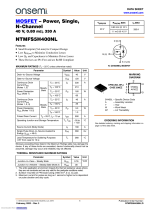
www.vishay.com
2
Document Number: 73411
S09-2434-Rev. C, 16-Nov-09
Vishay Siliconix
Si4946BEY
Notes:
a. Pulse test; pulse width ≤ 300 µs, duty cycle ≤ 2 %.
b. Guaranteed by design, not subject to production testing.
Stresses beyond those listed under “Absolute Maximum Ratings” may cause permanent damage to the device. These are stress ratings only, and functional operation
of the device at these or any other conditions beyond those indicated in the operational sections of the specifications is not implied. Exposure to absolute maximum
rating conditions for extended periods may affect device reliability.
SPECIFICATIONS TJ = 25 °C, unless otherwise noted
Parameter Symbol Test Conditions Min. Typ. Max. Unit
Static
Drain-Source Breakdown Voltage VDS VGS = 0 V, ID = 250 µA 60 V
VDS Temperature Coefficient ΔVDS/TJ ID = 250 µA 53 mV/°C
VGS(th) Temperature Coefficient ΔVGS(th)/TJ - 6.7
Gate-Source Threshold Voltage VGS(th) VDS = VGS, ID = 250 µA 1.0 2.4 3.0 V
Gate-Source Leakage IGSS VDS = 0 V, VGS = ± 20 V ± 100 nA
Zero Gate Voltage Drain Current IDSS
VDS = 60 V, VGS = 0 V 1µA
VDS = 60 V, VGS = 0 V, TJ = 55 °C 10
On-State Drain CurrentaID(on) V
DS ≥ 5 V, VGS = 10 V 30 A
Drain-Source On-State ResistanceaRDS(on)
VGS = 10 V, ID = 5.3 A 0.033 0.041 Ω
VGS = 4.5 V, ID = 4.7 A 0.041 0.052
Forward Transconductanceagfs VDS = 15 V, ID = 5.3 A 24 S
Dynamicb
Input Capacitance Ciss
VDS = 30 V, VGS = 0 V, f = 1 MHz
840
pFOutput Capacitance Coss 71
Reverse Transfer Capacitance Crss 44
Total Gate Charge Qg
VDS = 30 V, VGS = 10 V, ID = 5.3 A 17 25
nC
VDS = 30 V, VGS = 5 V, ID = 5.3 A
9.2 12
Gate-Source Charge Qgs 3.3
Gate-Drain Charge Qgd 3.7
Gate Resistance Rgf = 1 MHz 3.1 6.5 9.5 Ω
Tur n - O n D e l ay Time td(on)
VDD = 30 V, RL = 6.8 Ω
ID ≅ 4.4 A, VGEN = 4.5 V, Rg = 1 Ω
20 30
ns
Rise Time tr120 180
Turn-Off Delay Time td(off) 20 30
Fall Time tf30 45
Tur n - O n D e l ay Time td(on)
VDD = 30 V, RL = 6.8 Ω
ID ≅ 4.4 A, VGEN = 10 V, Rg = 1 Ω
10 15
Rise Time tr12 20
Turn-Off Delay Time td(off) 25 40
Fall Time tf10 15
Drain-Source Body Diode Characteristics
Continuous Source-Drain Diode Current ISTC = 25 °C 3.1 A
Pulse Diode Forward CurrentaISM 30
Body Diode Voltage VSD IS = 2 A 0.8 1.2 V
Body Diode Reverse Recovery Time trr
IF = 4.4 A, dI/dt = 100 A/µs, TJ = 25 °C
25 50 ns
Body Diode Reverse Recovery Charge Qrr 25 50 nC
Reverse Recovery Fall Time ta18 ns
Reverse Recovery Rise Time tb7
Downloaded from Arrow.com.Downloaded from Arrow.com.










